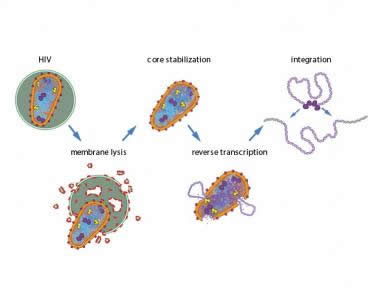NIAID-Supported Research Unveils Characteristics of Key Steps in HIV Life Cycle
 This illustration summarizes the steps the researchers took to make HIV reverse transcription and integration happen in a test tube. At top left is HIV. The scientists added a substance called melittin to punch holes in the viral membrane and release the internal core particle. Then they added nucleic-acid building blocks and compounds to stabilize the outer capsid shell of the core particle and allow reverse transcription to go to completion inside it. In some cases, the resulting HIV DNA (purple) extruded from small holes in the capsid. Finally, by adding extracts from human cells, the scientists created conditions that allowed the complete integration of HIV DNA into a target DNA (grey).
This illustration summarizes the steps the researchers took to make HIV reverse transcription and integration happen in a test tube. At top left is HIV. The scientists added a substance called melittin to punch holes in the viral membrane and release the internal core particle. Then they added nucleic-acid building blocks and compounds to stabilize the outer capsid shell of the core particle and allow reverse transcription to go to completion inside it. In some cases, the resulting HIV DNA (purple) extruded from small holes in the capsid. Finally, by adding extracts from human cells, the scientists created conditions that allowed the complete integration of HIV DNA into a target DNA (grey).
Credit: Janet Iwasa and Devin Christensen, University of Utah HealthOctober 19, 2020 - New NIAID-funded research answers longstanding questions about key steps in HIV replication. The scientists who conducted the research are the first to create an environment in a test tube where they could watch the unfolding of early events in the HIV life cycle that typically take place deep inside a cell, obstructed from view. Their experiments, published in the journal Science, mark the first time scientists have made these events happen outside of a cell.
The research was led by Wesley I. Sundquist, Ph.D., distinguished professor of biochemistry at University of Utah Health, and Owen Pornillos, Ph.D., formerly a trainee of Dr. Sundquist's and now an associate professor at the University of Virginia.
It has long been known that after HIV enters a cell, its genetic material single-stranded RNAgets converted into double-stranded DNA by an enzyme called reverse transcriptase and is then integrated into the cell's DNA by an enzyme called integrase. But the conditions under which reverse transcription and integration occur have been under debate for many years.
Central to that debate has been the role of a cone-shaped capsule nestled inside the spherical membrane that encloses the virus. This capsule, called the HIV capsid, contains viral RNA, reverse transcriptase, integrase and other molecules the virus needs to replicate inside a cell. In recent years, scientists have questioned whether reverse transcription can take place inside the capsid and whether an intact capsid might even promote this process.
When Drs. Sundquist, Pornillos and colleagues provided the nucleic-acid building blocks and cellular molecules required to stabilize the capsid, reverse transcription went to completion in a test tube. However, when the investigators used genetic and biochemical methods to destabilize the capsid, reverse transcription could not efficiently convert HIV RNA into DNA.
The scientists were able to confirm this visually thanks to recent advances in cryo-electron microscopy and molecular modeling. Their imaging revealed that most capsids remained intact or nearly so during DNA synthesis, except in some cases for the loss of a few surface patches through which loops of the growing DNA molecule sometimes extruded. These findings clarify that reverse transcription must take place inside a largely intact capsid. This discovery comes 50 years after the publication of the original papers showing that reverse transcription can take place, contrary to the dogma at the time that information only flowed from DNA to RNA to protein.
The scientists then explored whether their newly formed HIV DNA could integrate itself into a circular DNA molecule in their test-tube system, much as HIV DNA integrates into the genome of a cell the virus infects. Removing the capsid from the test tube and adding soluble material from human cells enabled the complete copy of HIV DNA to fully integrate into the circular DNA. Further research is needed to determine which components of the cell extract were critical to integration.
###
References:
DE Christensen et al. Reconstitution and visualization of HIV-1 capsid-dependent replication and integration in vitro. Science DOI: 10.1126/science.abc8420 (2020).
D Baltimore. RNA-dependent DNA polymerase in virions of RNA tumour viruses. Nature DOI: 10.1038/2261209a0 (1970).
HM Temin & Satoshi Mizutani. RNA-dependent DNA polymerase in virions of Rous sarcoma virus. Nature DOI: 10.1038/2261211a0(1970).
Contact the NIAID Media Team.
301-402-1663
niaidnews@niaid.nih.gov
###
Source: NIH: National Institute of Allergy and Infectious Diseases
For more HIV and AIDS News visit...
Positively Positive - Living with HIV/AIDS:
HIV/AIDS News |